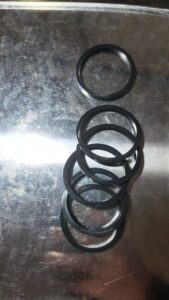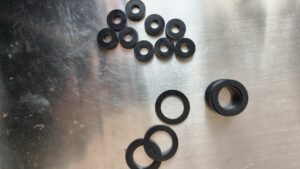Table of Contents
ToggleWhat is a Square O-Ring Called?
A square O-ring, characterized by its rectangular or square cross-section, is most accurately referred to as a Square O-Ring or Square Cross-Section O-Ring. While traditional O-rings have a circular profile, square O-rings provide unique advantages in specific sealing scenarios. Below is a comprehensive breakdown of its nomenclature, design, applications, and comparisons, optimized for clarity and alignment with the title while retaining original content.


1. Core Definitions and Technical Terminology
Primary Names
- Square O-Ring: The standard industry term for toroidal seals with a square cross-section.
- Square Cross-Section Seal: Emphasizes the geometric profile for technical clarity.
Alternative Terms
- Square Ring: A widely accepted generic name.
- Square-Cut Ring: Highlights manufacturing via lathe-cutting from extruded tubing.
- Lathe-Cut Ring: Refers to seals produced by cutting square-profile elastomer tubes.
- TetraSeal©: A trademarked variant of square rings used in specialized applications.
- Washer Ring: Describes its flat, washer-like sealing surfaces.
Note: Terms like Quad-Ring® (for X-shaped seals) are distinct and not interchangeable with square O-rings.
2. Design and Manufacturing Methods
Key Features
- Cross-Section: Square or rectangular profile, offering four flat sealing surfaces.
- Material Compatibility: Made from elastomers like nitrile (NBR), fluorocarbon (FKM), silicone (VMQ), or EPDM.
- Static Sealing: Excels in non-moving joints due to increased contact area.
Production Techniques
- Molding:
- Compression or injection molding creates seamless square-profile rings.
- Ideal for high-volume production.
- Extrusion & Cutting:
- Extruded square tubing is cut to size, cost-effective for custom orders.
- Machining:
- Used for large or specialty-material rings where molding is impractical.
3. Advantages of Square O-Rings
| Feature | Benefit |
| Enhanced Compression | Flat faces distribute load evenly, reducing extrusion under high pressure. |
| Space Efficiency | Fits into narrow gland grooves, ideal for compact designs. |
| Static Sealing | Superior sealing in non-moving applications (e.g., flanges, pipe joints). |
| Cost-Effectiveness | Often cheaper than custom-molded O-rings, especially in low volumes. |
4. Common Applications
Industrial and Mechanical Systems
- Hydraulic Systems: Seals piston heads in heavy machinery.
- Plumbing: Static seals for high-pressure pipe flanges.
- Aerospace: Fuel and hydraulic line seals in aircraft.
- Retrofitting: Direct replacement for round O-rings in existing AS-568 grooves.
Specialized Uses
- High-Pressure Gaskets: Maintains integrity in thin housings.
- Chemical Processing: Resists aggressive media when made from FKM or EPDM.
5. Comparison with Round O-Rings
| Aspect | Square O-Ring | Round O-Ring |
| Cross-Section | Square/rectangular profile. | Circular profile. |
| Contact Area | Four flat faces for broader sealing surface. | Single line contact. |
| Pressure Handling | Resists extrusion better under high pressure. | Prone to deformation in extreme pressure. |
| Dynamic Use | Limited to low-motion applications. | Suitable for dynamic and static sealing. |
| Cost | Economical for custom/low-volume production. | Cost-effective for high-volume molded parts. |
6. Material Selection
| Material | Properties | Typical Applications |
| Nitrile (NBR) | Oil/fuel resistance; cost-effective. | Automotive, hydraulic systems. |
| Fluorocarbon (FKM) | High-temperature/chemical resistance. | Aerospace, chemical processing. |
| Silicone (VMQ) | Flexibility across extreme temperatures. | Food-grade machinery, medical devices. |
| EPDM | Weather/ozone resistance; handles steam/water. | Outdoor equipment, HVAC systems. |
7. When to Choose a Square O-Ring?
- High-Pressure Static Seals: Minimizes deformation under load.
- Space-Constrained Grooves: Compact design for tight installations.
- Retrofitting Existing Systems: Drop-in replacement for round O-rings.
8. Limitations and Considerations
- Dynamic Applications: Poor performance in high-speed rotating or reciprocating systems.
- Gland Design: Requires precise groove dimensions to avoid over-compression.
- Material Compatibility: Must match operating temperature and chemical exposure.
9. Real-World Examples
- Hydraulic Cylinder Retrofit: Replacing a worn round O-ring with a square ring in a piston seal improves pressure resistance.
- Aircraft Fuel Line: A square FKM ring ensures leak-free performance under extreme temperatures.
Conclusion
A square O-ring, formally termed a Square Ring or Square Cross-Section O-Ring, is a versatile sealing solution optimized for static, high-pressure environments. Its flat profile enhances sealing efficiency in constrained spaces and demanding conditions, making it a cost-effective alternative to traditional round O-rings in specific applications. While unsuitable for dynamic systems, proper material and gland design ensure reliable performance in industries ranging from aerospace to plumbing.



Leave A Comment